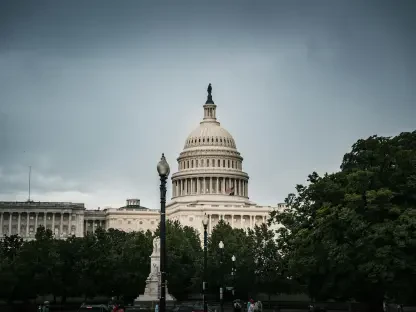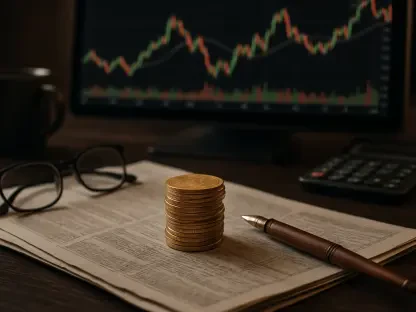Trade deals have played a pivotal role in shaping global economies, and their impact on stock markets is profound and multifaceted. Over recent years, the stock market has witnessed significant movements driven by announcements and expectations of trade agreements. The question that looms large for investors and analysts alike is whether these rallies, buoyed by trade optimism, are sustainable in the long run. Bank of America’s chief investment strategist, Michael Hartnett, provides an insightful analysis of the current market sentiment, delving into both the optimism and the underlying risks associated with such expectations. With the S&P 500 experiencing a remarkable ascent, climbing nearly 14% from its lows in April, Hartnett emphasizes a scenario where market enthusiasm might surpass factual considerations.
Investor Optimism and Its Potential Pitfalls
The Influence of Trade Expectations
The anticipation of new trade deals has created a wave of optimism among investors, propelling stock markets to new heights. Hartnett’s perspective on this rally suggests that these expectations might be detached from the economic fundamentals that typically support long-term growth. The phenomenon of “buy the expectation, sell the fact” aptly captures the current market dynamics. This approach, largely reactive to news rather than grounded in concrete financial developments, often results in temporary uplifts, only to be followed by potential corrections when the realization does not meet the inflated expectations. As trade agreements come to fruition, the initial enthusiasm may wane, paving the way for a market pullback.
Particularly pertinent in this context is the notion of “US exceptionalism,” a term used to describe investor confidence driven by perceived American economic superiority. This overconfidence potentially overlooks crucial factors, such as emerging populist policies, that could adversely affect economic stability. Policies involving higher tariffs, stricter immigration controls, and fiscal conservatism pose genuine risks, potentially stalling economic growth. As Hartnett advocates, this optimistic outlook should be reassessed given these threats, especially since such policies are increasingly seen as double-edged swords in the global economic arena.
Risks Hidden Underneath Optimism
Further dissecting the situation, Hartnett presents a cautionary perspective contrasting with more optimistic views from institutions like Deutsche Bank, which foresees benefits from reduced tariffs, or Morgan Stanley, which anticipates a boost from a potential US-China trade accord. The divergence in these viewpoints highlights the complexity and unpredictability of trade deal outcomes. Hartnett advises that diversification could be a prudent strategy, suggesting a shift from US equities to international markets, bonds, and gold. Such diversification could shield investors from regional economic uncertainties and potential downturns in US markets.
The call for caution until clarity on several fronts—tax reforms, trade negotiations with China, and interest rate policies—is a testament to the unpredictability that surrounds economic forecasts in the context of changing political climates. Investors are encouraged to adopt a more balanced approach, recognizing that the current bullish sentiment may not capture all the intricacies and eventual implications of finalized agreements. This consideration becomes vital as political and economic landscapes continue to evolve unpredictably.
Strategic Implications for Investors
Diversification as a Shield Against Volatility
In light of Hartnett’s analysis, the importance of strategic diversification becomes evident. With US markets appearing buoyant yet vulnerable to abrupt shifts, international markets, bonds, and precious metals like gold emerge as attractive alternatives. Such diversification not only spreads risk but also positions investors to capitalize on opportunities beyond domestic boundaries. The interconnectedness of global markets means that changes in one region can have ripple effects worldwide, so a diversified portfolio can effectively cushion against such volatilities.
Furthermore, the concept of balance within investments cannot be overstated. While the allure of a booming stock market may be tempting, a diversified approach aligns with prudent risk management. By exploring various asset classes, investors can potentially benefit from growth in sectors less influenced by domestic trade policies, thereby stabilizing returns during uncertain times. Such a strategy requires timely evaluation and adjustments based on shifting economic indicators and geopolitical developments.
Long-Term vs. Short-Term Outlooks
Hartnett’s suggestions underscore the importance of distinguishing between long-term and short-term market strategies. While short-term gains driven by market euphoria are enticing, long-term stability necessitates grounded decision-making backed by tangible economic indicators. Investors should remain wary of speculation fueled by news cycles, recognizing the difference between transient market optimism and sustainable growth trends. A focus on long-term objectives offers resilience against market volatilities and positions investors to withstand unexpected downturns.
At this juncture, cultivating a comprehensive understanding of both domestic and international markets becomes crucial. Given the complexity of trade relationships and their profound impact on global economies, staying informed about geopolitical shifts and their potential repercussions on investments is essential. Thus, an informed approach, incorporating lessons from past market behaviors while remaining adaptive to new data and trends, can serve investors well in navigating the twisting paths of financial markets.
Navigating an Uncertain Future
Investor enthusiasm over potential new trade deals has sparked a surge in stock markets, driving them to unprecedented levels. According to Hartnett, this rally may not be backed by the solid economic fundamentals necessary for sustainable growth. The idea of “buy the expectation, sell the fact” aptly describes current market behavior, driven by anticipated news rather than concrete economic developments. This leads to temporary rises, often followed by corrections when reality doesn’t match the hype. As trade deals materialize, initial excitement might fade, potentially triggering a market downturn.
Central to this discussion is the concept of “US exceptionalism,” where investors’ belief in American economic dominance bolsters confidence. This optimism can obscure significant risks like emerging populist policies, which might destabilize the economy. Policies like increased tariffs, stricter immigration, and fiscal conservatism pose real threats to growth. Hartnett suggests this optimistic view needs reevaluation, as these policies could become harmful in the competitive global economic landscape.









